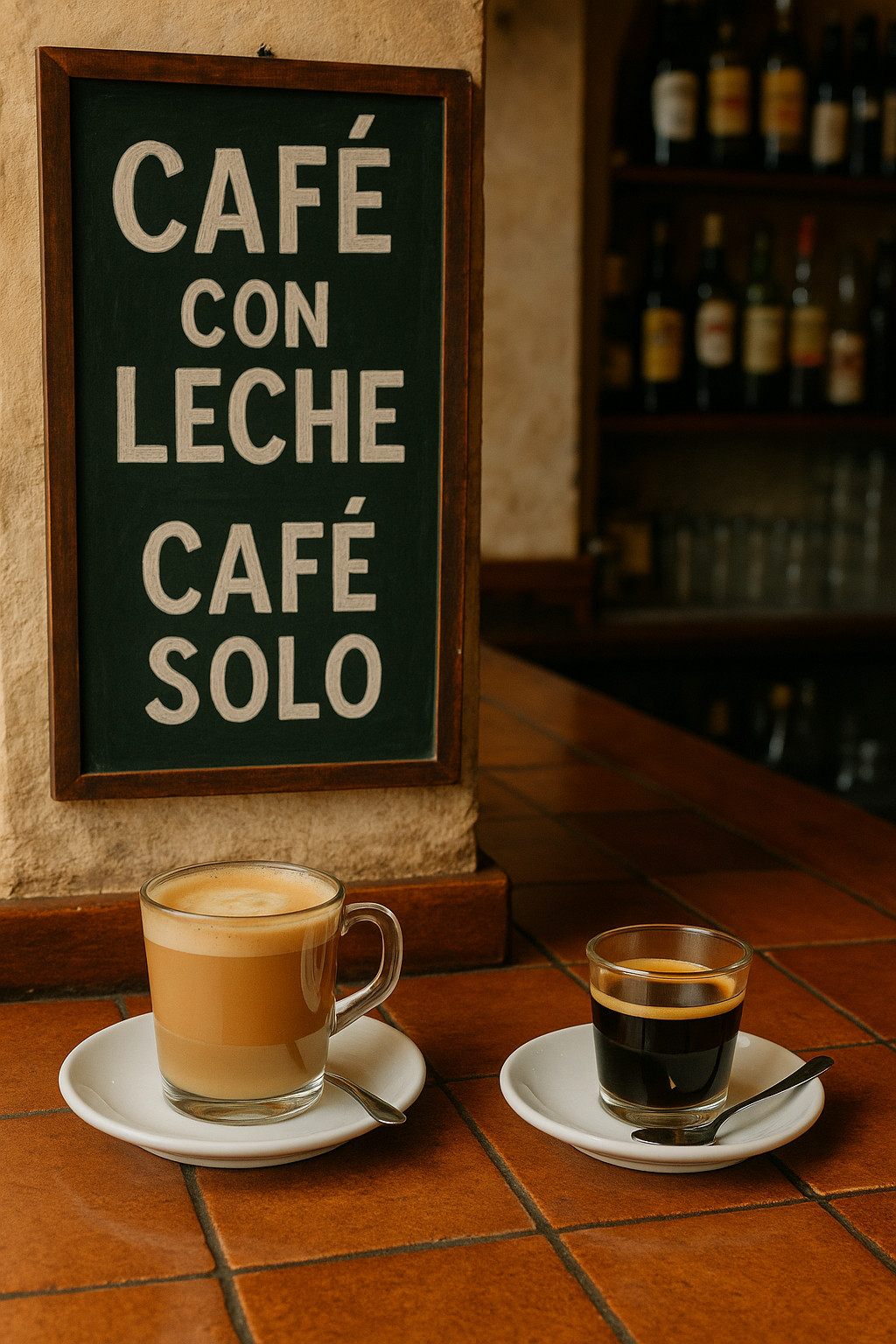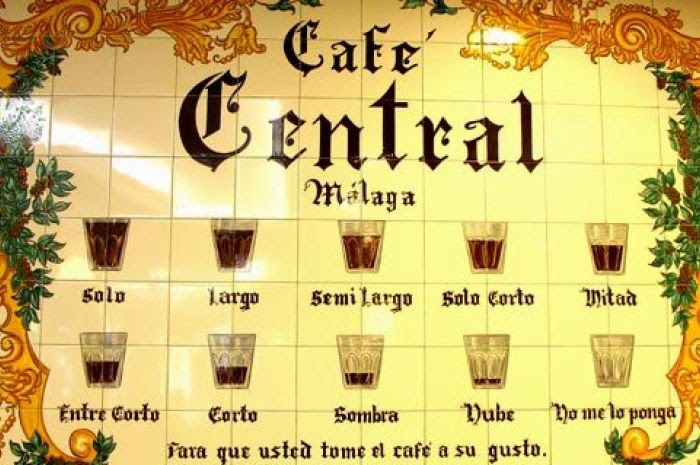
A Guide to Spanish coffee culture: drink, enjoy, and speak like a local
In Spain, coffee is more than just a beverage; it's an integral part of daily life and social interaction. Spaniards often use coffee as an excuse to meet with friends, family, or colleagues, using the phrase "ir a tomar un café" (to go have a coffee) as a synonym for socializing. Coffee is drunk throughout the day, not just in the morning, and it's always present in the Spanish daily routine.

The Spanish coffee ritual invites you to linger and chat, strengthening bonds and making daily life more relaxed. This means that by immersing yourself in Spanish coffee culture, you also embrace a different rhythm of life, where human connection is valued far above efficiency.
Upon arriving in Spain, many newcomers are surprised to find that the familiar taste of coffee can be different here. Sometimes it seems unusually bitter, even "burnt," often leading to the assumption of poor quality beans or a bad establishment. However, behind this characteristic lies torrefacto – a unique historical roasting method that has long been a cornerstone of Spanish coffee culture. The essence is that a small amount of sugar is added to the coffee beans during roasting. This process not only gave it a characteristic, intense, and often bitter taste, but also, importantly, helped preserve the coffee during times of scarcity and civil war when good beans were scarce. So, when you taste such coffee, remember: it's not a barista's mistake, but a part of a rich history and tradition that is gradually giving way, but still present in the hearts of many Spaniards and their morning rituals, especially outside of large cities with their growing specialty coffee culture.
Morning Boost: Breakfast and Morning Coffee Habits
Spaniards usually start their day with café con leche, which often serves as their main sustenance before leaving home. This first cup provides a quick caffeine boost, with a more substantial breakfast often following later in the morning. Due to the unique Spanish schedule with very late lunches and dinners, a second cup of coffee is common during a mid-morning snack, usually with a small sandwich or croissant.
The "two breakfasts" system (initial coffee + later morning snack/coffee) is a direct consequence of the unique Spanish schedule, where people eat late, and a great way to maintain energy throughout the long day. There's a fairly large gap between the light early breakfast and the late lunch (often at 2-3 pm).
Afternoon Pick-Me-Up: Coffee After Lunch
To maintain energy in the afternoon, another cup of coffee is simply needed. For those looking for a lower-caffeine option in the afternoon, a manchado (mostly milk with a little coffee) is often recommended. It's noteworthy that coffee is traditionally served after dessert, not with it — a sort of final flourish to the meal.
Main Types of Coffee
- Café Solo: This is the Spanish equivalent of espresso – a small, strong, black coffee. If you simply ask for «un café» (a coffee), this is usually what you will be served. For a very small portion, you can specify «corto» or «muy corto de café».
- Café Doble: Double espresso.
- Americano: If you prefer a larger cup of black coffee, «Americano» is what you need. Essentially, it's espresso diluted with hot water, making it weaker than café solo, but probably still stronger than many are used to. It is not served with milk.
- Cortado: This is espresso "cut" (cortado literally means "cut") with a small amount or a splash of foamed milk. It is stronger than café con leche and is often served in a small glass. In some regions, it may be called café manchado (stained coffee).
- Café con Leche: The most popular coffee with milk in Spain, usually made with equal parts espresso and foamed milk, served in a latte-sized ceramic cup. For a version with more milk, you can ask for «en vaso» (in a glass), which usually results in a ratio of about one-third coffee and two-thirds milk. It is similar to a latte, but usually contains less milk and foam.
Seasonal Favorites
- Café con Hielo: This is a very popular choice during the warm summer months. It consists of hot espresso served with a separate glass filled with one or two ice cubes. The special thing is that you pour the hot coffee over the ice yourself. Important tip: add sugar to the hot coffee.
Unique Spanish Variations
- Café Bombón: A sweet treat, this drink combines espresso with condensed milk, often served in a clear glass to showcase the layers.
- Carajillo: For those seeking an alcoholic kick, the Carajillo is coffee mixed with liqueur, typically brandy, but whiskey, rum, or anise liqueur are also popular substitutes.
Beyond the Cup: What to Pair with Coffee
The Spanish breakfast (el desayuno) is usually the lightest meal of the day, often light and carbohydrate-based.
- Tostadas: A very popular choice, consisting of toasted bread. It can be served simply with butter and jam (con mantequilla y mermelada) or, more commonly, with olive oil and fresh tomato (con tomate y aceite).
- Churros: Although often considered a dessert, churros are a traditional Spanish breakfast dish, usually served with thick, sweet hot chocolate for dipping.
- Pastries: Various pastries are popular here, such as croissants, magdalena (Spanish muffins/cupcakes, perfect for dipping), napolitana (chocolate croissants).
- Pincho de Tortilla: A hearty slice of Spanish potato omelet (tortilla de patatas) is a popular choice for "second breakfast," especially in Madrid and northern Spain.
- Sandwiches: Quick and tasty small sandwiches, known as bocadillos (general name), pulgas (in Madrid) or entrepan (in Barcelona), come with various fillings such as Spanish ham, cheese, or a simple egg omelet.
- Freshly squeezed orange juice (Zumo de Naranja) is a common and readily available addition to breakfast.
Etiquette and Phrases for Ordering
In Spanish cafes, you usually attract the waiter's attention by raising your hand and making eye contact. They expect you to be ready to order when they approach, sometimes asking «Dime» (tell me). Unlike some other cultures, tipping in Spain is not mandatory and not expected, but of course, always welcome for good service.
Phrases for ordering coffee:
- «Un café, por favor» – Coffee, please.
- «Café doble, por favor» – Double coffee, please.
- «Me da un cortado, por favor» – Give me a cortado, please.
- «Ponme un café con leche, por favor» - Give me coffee with milk.
- El café descafeinado — decaffeinated coffee.
Milk and Sugar:
- "¿Y cómo quiere su leche?" – How would you like your milk? (Question from the barista)
- "Caliente" – Hot.
- "Templada" – Warm.
- "Fría" – Cold.
- Leche entera — whole milk.
- Leche semi-desnatada — semi-skimmed milk.
- Leche desnatada — skimmed milk.
- "Leche de soja" – Soy milk.
- "Leche de avena" – Oat milk.
- "Con azúcar" – With sugar.
- "Sin azúcar" – Without sugar.
Clarifying the location:
- "¿Para tomar adentro o afuera?" – To drink inside or outside? (Question from the barista)
- "Para (tomar) aquí." – To drink here.
- "Para llevar." – To go. (Be prepared for simple packaging, such as a styrofoam cup.)
- "En vaso" – In a glass. (Usually for coffee with milk, to get more milk).
- "En taza" – In a cup.
Coffee accessories
- La cucharilla — teaspoon.
- La servilleta — napkin.
- El vaso — glass.
- La taza — cup.
Requesting the bill:
- «La cuenta, por favor.» – The bill, please.
Common phrases for ordering and service:
- Quiero un/una... — I want... (one...)
- Me pones un/una... – Can you give me... (more colloquial)
- Por favor — please.
- Gracias — thank you.
- ¿Me puede traer...? – Could you bring...?
- ¿Está libre esta mesa? — Is this table free?
Expert Commentary

Spain is probably the OECD (developed) country that consumes/consumed the worst coffee. This is due to the legacy of torrefacto (a type of roasting), because if you're going to roast it that way, it doesn't matter if the bean is good. In the world of coffee, there are robustas and arabicas; the former are cheaper but of lower quality, more bitter, and have twice the caffeine. The latter are more expensive but more subtle and smooth, and have much less caffeine. Spain consumes robustas massively. Furthermore, they are very low-quality robustas. Therefore, to hide the defects of the beans, they are roasted very dark. This makes the coffee taste burnt, like burnt rubber. A characteristic flavor of typical bar coffee. Because they consume robustas that are bitter, burnt, and have a lot of caffeine, Spaniards consume the most sugar and milk with their coffee. They also consume the most decaf. This is changing now, just as wine culture changed. We are making the leap to specialty arabica coffees with lighter roasts and, with knowledgeable baristas and significantly improved basic cleaning routines, such as carefully cleaning the milk frothing wand and the portafilter after each coffee. In fact, to know what kind of coffee you're going to get in a café, just look at the milk frothing wand. If it's dirty with milk stuck on it forming a crust, you know that the attention to coffee in that place is nonexistent... And that's all. As an anecdote, in some areas of Spain there are dozens of ways/combinations to order a coffee. Málaga is one of them... I'll leave you with the iconic photo.

Conclusion
Spanish coffee culture is a unique combination of traditions, social rituals, and evolving preferences. For those relocating, understanding these nuances is crucial for easy adaptation and full immersion in local life. Coffee in Spain is not just a beverage for energy, but a deeply rooted social ritual that sets the daily rhythm and serves as an occasion for communication.